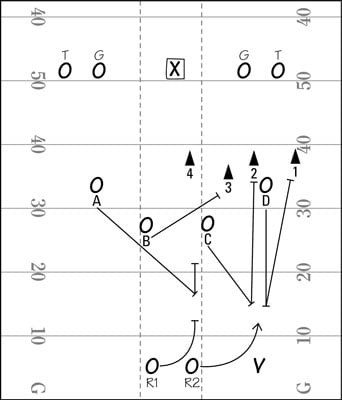The ultimate purpose of a kickoff return in football is to score or advance the ball as close to midfield (or beyond it) as possible. A football team’s ability to start out on offense in better-than-average field position greatly increases its chances for success.
Great kickoff returners possess the following traits:
The innate ability to sense where the tackling pursuit is coming from and move quickly away from it
Follows his initial blocks and, after that, relies on his open-field running ability or simply runs as fast as he can through the first opening
Able to run a 4.3-second 40-yard dash, as well as have enough body control to be able to use that speed properly
Understanding the kickoff return rules
The following rules govern the kickoff return:
No member of the receiving team can cross the 40-yard line until the ball is kicked.
Blockers can’t block opponents below the waist or in the back.
If the momentum of the kick takes the receiver into the end zone, he doesn’t have to run the ball out. Instead, he can down the ball in the end zone for a touchback, in which case, his team takes it at the 20-yard line.
If the receiver catches the ball in the field of play and retreats into the end zone, he must bring the ball out of the end zone. If he’s tackled in the end zone, the kicking team records a safety and scores two points.
Setting up a blocking wedge
Good return teams set up a blocking wedge with two or three huge players aligned together (the NFL prohibited teams from using more than three players in 2009):
These huge players are usually offensive linemen, but defensive linemen can be part of the wedge, too.
They stand together, separated by two arm lengths, between the 15- and 25-yard lines, approximately 10 yards in front of the kick returner.
They must adjust their position on the field based on the depth of the kickoff. Most coaches like their wedge blockers to do a 90-degree turn and then accelerate forward prior to making blocking contact.
The wedge’s objective is to assist the return man in breaking free from the initial pursuit by creating a hole or lane in which the returner can run freely. Coaches want these blockers to remain on their feet and work together to free their man.
This figure shows a common kickoff return strategy involving a blocking wedge called the Trap 3 Right.

Here’s the setup for this strategy:
Five blockers, listed as tackle (T), guard (G), and center (the X in the rectangle), slightly inside the 45-yard line.
Four other blockers (A, B, C, and D) deeper, aligned between their own 25- and 30-yard lines.
After the ball is kicked, the players take the following actions:
C and D retreat to a position 10 yards in front of R2, a receiver, who has the ball near the right hash. (V marks the receiving spot.)
R1, also a receiver but on the left hash, runs faster, positioning himself with C and D to form a blocking wedge.
B runs horizontally and blocks kick coverage man 3.
Blocker A retreats in order to prevent any cover man from breaking through and tackling R2.
R2 has the option of running ahead or cutting back to his left. R2 must find his own running lane if one doesn’t materialize between C and D.
Covering the kickoff return
Coverage men (the guys whose job it is to tackle the kick returner) must be aggressive, fast, and reckless in their pursuit. They must avoid the blocks of the return team. Special teams coaches believe that a solid tackle on the opening kickoff can set the tone for a game, especially if the return man is stopped inside his own 20-yard line.
The job of the kickoff coverage man isn’t an easy one. Players get knocked down once, twice, and sometimes three times during their pursuit of the kickoff returner. Not for nothing is the coverage team sometimes called the “suicide squad.”

